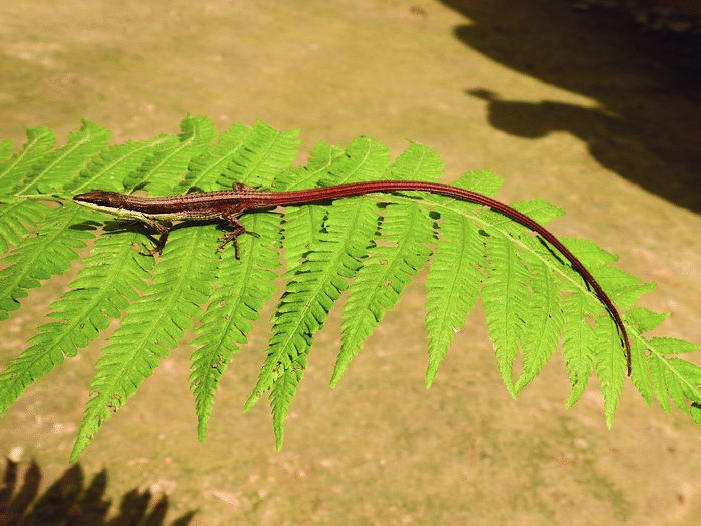 Listen to this article
•
15:34 min
Listen to this article
•
15:34 min
In 2020, zoologist Bivek Gautam and members of his team were exploring the forests of eastern Nepal on an expedition to look for the Himalayan salamander (Tylototriton himalayanus). That’s when they encountered a lizard different in appearance from others they had seen before. It was an entirely new creature in the regions.
“We only managed to get a glimpse of it,” Gautam told Mongabay, adding he was left wondering about the identity of the lizard. “A year later, when we returned, we managed to get a much closer look at the lizard.”
This time the researchers managed to capture, observe and take measurements of the lizard similar to the one they had spotted a year before. In a recently published study, they concluded that what they had was a specimen of an elusive lizard species, Takydromus sikkimensis, previously thought to be found only in Sikkim in India (hence the specific name sikkimensis).
“After observing the scales and its four pairs of femoral pores, 12 rows of ventral scales, and a tail more than 3.6 times longer than snout-vent length, we came to a conclusion that it was the Sikkim grass lizard,” Gautam said. “After identifying the species, our excitement increased when we learnt about its history,” he added.
There’s so little known about the species that researchers have at times even doubted that it exists. The Sikkim grass lizard was first described in 1888 by German-British zoologist Albert Günther on the basis of a description of grass lizards from Sikkim by Czech paleontologist Ferdinand Stoliczka in 1872. Belgian-British zoologist Albert Boulenger and other researchers after him said they believed the Sikkim grass lizard was simply a northern population of the Asian grass lizard (Takydromus sexlineatus).

Cover Photo: A Sikkim grass lizard spotted in eastern Nepal. Photo courtesy: Bivek Gautam
However, a team led by Indian herpetologist Subramanian Bhupathy in 2009 spotted the grass lizard in the lower Teesta valley of Sikkim, confirming that the lizard exists.
In 2021, the IUCN, the global wildlife conservation authority, classified the species as endangered as it was believed to be restricted to a range of only around 19 square kilometers (7 square miles) in the Teesta Valley in Sikkim. The IUCN assessment noted that the quality and extent of the species’ habitat are under threat from agricultural activities and the construction of a hydroelectric dam.
“When we visited the area again in 2022, we spotted the lizard again,” Gautam said. “The aerial distance between Sikkim and the area where we spotted the lizard is around 92 kilometers [57 miles].”
Veteran herpetologists in Nepal say this first confirmed sighting of the lizard species in Nepal highlights the need to invest more in the study of reptiles in the country. “We can say that only around half of the reptile species recorded in neighbouring India and China have been recorded so far in Nepal,” said herpetologist Karan Bahadur Shah, former director of the Natural History Museum at Tribhuvan University in Kathmandu.
Shah said that with iconic species such as tigers and rhinos getting all the conservation attention, research on the country’s herpetofauna has been limited. “Only a handful of people dedicated to their study are working on it,” he told Mongabay.
“I wouldn’t be surprised if more herpetofauna is discovered in Nepal in the near future if more people get involved in it,” he added.
Gautam said that in addition to more research, it’s also necessary to address the threats that lizards in general face in Nepal. “While climate change and habitat destruction are major threats to lizards, human attitudes toward these animals also pose a challenge,” he said.
“For example, famers kill lizards believing that they attack chicken and make holes in fields where water needs to be retained. Similarly, children living in rural areas ‘play’ with lizards by plucking their tail and tying them up with strings,” he said. “To address these threats, we need to increase public awareness.”





